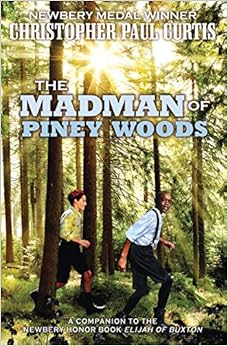 The Madman of Piney Woods
The Madman of Piney WoodsChristopher Paul Curtis
Scholastic, 2014 363 pgs.
Grades 4-7
Historical Fiction
Curtis revisits Buxton, Ontario, a town founded by runaway slaves fifty years before our story takes place and the setting for his Newbery honor book Elijah of Buxton. Alternating chapters tell the stories of Benji and Red in turn of the century Canada. Benji is a descendant of slaves and resides in Buxton. He longs to be a journalist and feels overshadowed by the talents of of his younger twin siblings, who are already talented carpenters. His parents secure him an apprenticeship at a nearby newspaper, where he begins to hone his craft. Meanwhile, Red lives in nearby Chatham with his widowed judge father and grandmother. His grandmother is a survivor of the Irish potato famine and has a horrific tale to tell about her immigration experience. Grandmother's past has left her bitter, intolerant and racist. Red, often the victim of her attacks, begins to question Grandmother's behavior and make his own choices about other people and races. At a speech making contest, where both of their friends are contestants, Red and Benji finally meet and become friends. They have a lot in common, including a love of the woods, which Red is very knowledgeable about. In the woods lives the famous "Madman" or "Lion Man", whose name differs depending on which town you are from. The Madman is really a post traumatic stress suffering veteran of the Civil War, who can no longer function in society. Red is tipped off by a friend that the Madman has been shot and the two boys rush into the woods to try to find and save him. They do find the Madman, get help, and bring him to safety. The identity of the Madman, the results of his recovery, and the future of the friendship of the two boys (especially after being discovered by racist Grandmother) are all resolved by book's end.
I read Elijah of Buxton when it came out in 2007. I didn't love it as much as others works of Curtis (I'm a devoted fan of The Watson's go to Birmingham). Elijah didn't stick with me and I had to skim a bit of it before tackling The Madman of Piney Woods. Even though the second book takes place a generation after the first book, some characters carry over (Elijah is now the mayor and the Madman's is a former character). It is interesting to see how Buxton evolved as a town after the passing of the former slaves who founded it and to see it in relation to its neighbors. Curtis points out the prejudices of Canadians at the time against other ethnic groups, including the Irish and then shows how survivors of discrimination can become even worse discriminators. The book has some great lessons, both historical and moralist, and shows the power of friendship. Some of the themes, such as discrimination and the post traumatic stress of veterans are still pertinent today. It took me a very long time to read this book. It was written very well, almost too well for casual reading. I had to re-read the first chapter over three times before I finally gave up and kept going. The first chapter made more sense by the end, when I re-read it again. I also kept getting Benji and Red confused, which was really my own fault because Curtis helpfully names the Irish boy "Red", making it easier for the reader to know which boy is talking. If I struggle getting into a book and continue to get confused as the I continue to read it, I can only imagine a ten year old giving it a try. If you can make it to the end, there is a pay-off as the boys work together to find the Madman and the mystery of his identity is revealed. So, I did like the book by the end and all the way through felt that it was well written, but I would not use it for a book discussion (the kids would all give up) or recommend it to anyone but the most serious young reader. This book may be the stuff of awards, but it is not for recreation use.
No comments:
Post a Comment